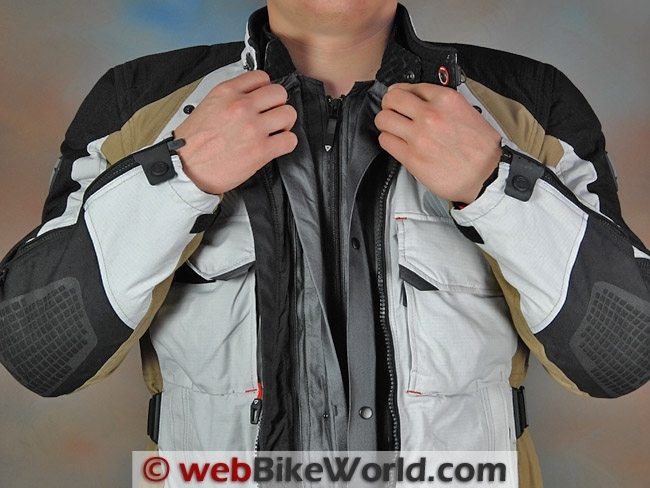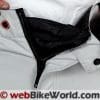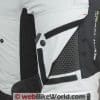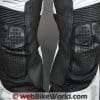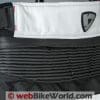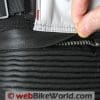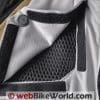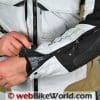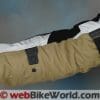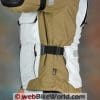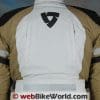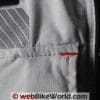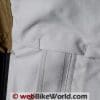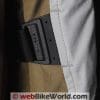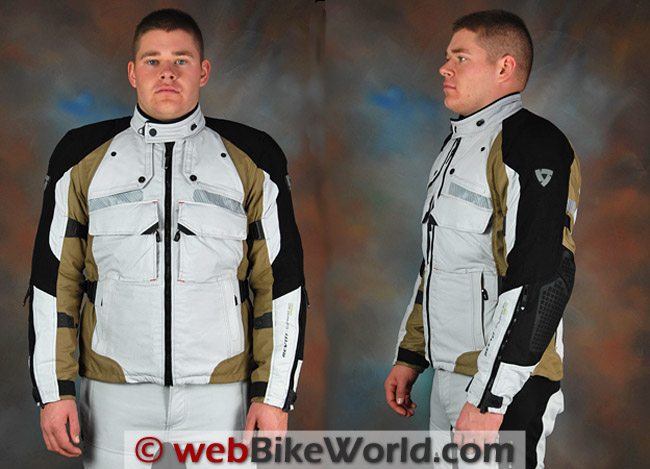The new REV’IT! Defender GTX jacket is the fifth generation of the original and very popular Cayenne and Cayenne Pro jackets.
The Cayenne Pro is still in the REV’IT! lineup and the Defender GTX is a new and even more advanced design.
The REV’IT! Everest GTX (review) is now sitting at the top of the heap, however.
The REV’IT! Defender GTX outfit was named the webBikeWorld 2010 Motorcycle Product of the Year!
Feedback and input from adventure touring riders around the world was incorporated into the Defender GTX to create the ultimate four-season jacket.
This is a serious tool designed for motorcyclists who are tough on equipment and demand the best.
If you’re a serious motorcycle rider — be it an adventure tourer, hard-core long-distance touring rider or just someone interested in the best quality available, you’re in the right place.
Indeed, if you’re interested in saving money, you’re also in the right place.
How can that be, you ask?
I know I’ve mentioned this before somewhere along the line: there’s a strong argument to be made for paying more and getting more, for gear that you know is going to last, all the while keeping you warm, dry and safe through all four seasons.
Lesser gear is usually a matter of compromise.
You’re probably not going to get the ultimate riding outfit — jacket and pants — for less than $500.
You may find a decent bargain, and there are plenty of good deals available on some very nice clothing from reputable brands, no doubt.
But for knowledgeable and serious riders who really depend on their gear and require ultimate performance, it’s all about the details.
Sometimes the details are subtle. You don’t even notice them until someone points them out — for example, the special bar tack stitching reinforcements on all of the wear points of the Defender GTX jacket and pants.
And there’s a chance that the details may never come into play; in fact, you hope they don’t. For example, let’s consider the Superfabric abrasion-resistant material on the arms and legs of the Defender GTX outfit.
You’ll never know it’s there unless you fall, and then you’ll be glad it’s included.
The moral of the story here is that you can spend a lot less on a jacket without these features and you may be perfectly happy — until the day arrives, sooner rather than later, that you wish you had forked over a few more shekels to do it right.
This is why serious motorcycle riders spend what it takes to get the best equipment. The day when the “professional” level details make the difference arrives much sooner for them.
It’s a matter of statistics — when you ride more or longer or farther or faster, the flaws are going to show up sooner rather than later.
There are so many of these subtle details in the new Defender GTX jacket and pants that it becomes a challenge just to describe them all.
I’ll try to do that here and this is included in the Part 1 and Part 2 YouTube videos I took at REV’IT! USA headquarters during my August 2010 visit which more fully describe the Defender GTX jacket as presented by Jordan Levitt, the Sales Director for REV’IT! USA.
Background
Think about it — you could buy a jacket and pair of pants for cold weather riding and then an outfit for summer and you’ve probably equaled the cost of a Defender GTX jacket and pants.
But I can pretty much guarantee you won’t be as comfortable or as safe — and you’ll be probably end up buying another outfit in 2-3 years when the cheapo starts to self-destruct. So where’s the savings?
I first described this prototype version of the new REV’IT! Defender GTX in my summer 2010 REV’IT! Gore-Tex report covering the REV’IT! lineup for fall/winter of 2010 and 2011.
The Defender GTX isn’t the top-of-the-line jacket for 2011; that honor belongs to the coming-soonREV’IT! Everest GTX jacket, the all-out, no expenses spared suit of armor using Gore-Tex Pro Shell Armacor with the special TFL Cool material that even bounces the sun.
The Defender GTX now sits between the former top-line REV’IT! jacket, the Cayenne Pro (review)and the new Everest GTX. REV’IT! said that the Defender GTX series is actually the 5th generation of adventure touring gear.
It all started with the original Cayenne (review) we reviewed in 2005. So that’s one evolutionary step per year, just like clockwork.
The five-year-old Cayenne is still a more advanced jacket than just about anything else available in 2010 and basically indestructible, so to think they’ve improved on the original concept five more times is mind-blowing.
But improve it they have, and nothing tells me that more than the recent rides we deliberately chose in some of the worst nor’easter Fall rainstorms I’ve ever witnessed — and certainly the worst I’ve ever ridden in.
It was a surreal experience, riding the Multistrada at 60 MPH, with rain, wind and torrent pummeling the countryside, all the while perfectly dry, perfectly comfortable and with a wry smile on my face.
This is 2011 technology at work my friends; unimaginable even five years ago when the original Cayenne was released.
I wonder what more the Everest GTX can possibly bring to the table? Of course, I’m anxious to find out! In the meantime, let’s take a look at the aptly-named Defender GTX.
REV’IT! Defender GTX Jacket Shell Key Features
Multiple Denier Shell Fabric
The outer shell of the Defender GTX jacket is a major departure from mainstream motorcycle wear. It’s constructed from a combination of three different types of Cordura: 500, 750 and 1000 denier, all Teflon-coated with ripstop.
The shell has a soft feel, which makes the jacket immediately comfortable without that stiff canvas feeling found in some other jackets.
By the way, denier is a term often used to describe the fabrics used in motorcycle clothing and other industries. It’s a measure of weight per unit length of the thread, usually defined as the mass in grams per 9,000 meters of a strand.
Lower numbers are finer threads and higher numbers are thicker threads.
REV’IT! mentions the lighter weight of the jacket, but if there’s a difference, it’s slight. The size large jacket with liners weighs 2.66 kg (5 lbs. 14 oz.), but the size large pants do seem lighter than average at 1.8 kg (4.0 lbs.).
Teflon Coating
The Teflon coating is a major difference in the jacket shell.
And even though the Defender GTX jacket has a Gore-Tex “Guaranteed to Keep You Dry” removable liner, the Teflon coating provides the outer shell with the ability to shed much of the water before it hits the liner.
The moisture then dries and disappears very quickly, as I experienced during our recent monsoon rides.
Ripstop Cordura
The “ripstop” material is often found in heavy-use outdoor gear, including everything from backpacks to sails to tents to military uniforms (BDU or Battle Dress Uniform).
The fabric is woven with a special cross-weave reinforcement pattern that helps prevent tears. If it gets punctured, the ripstop helps to prevent the puncture from turning into a longer tear.
The ripstop pattern can be seen in the photo of the vent above and in some of the other photos and also in the close-ups in these Part 1 and Part 2 YouTube videos.
The use of this type of fabric is one of the major differences between the Defender GTX jacket and pants and lesser types.
SuperFabric Abrasion Protection
Another noticeable difference is in the use of Superfabric abrasion-resistant panels on the elbows of the Defender GTX jacket and the knees of the matching pants.
We described Superfabric in previous REV’IT! clothing reviews and as far as I know, REV’IT! was the first company to use this material on motorcycle gear.
Superfabric is apparently expensive stuff; it’s also used in high-quality technical gear for military and police use and I’ve heard it’s used in some diving gear to protect divers from cuts while they’re underwater.
The manufacturer is HDM Inc. and they have a video illustrating some of the benefits of the product. They say that “tiny plates” (ceramic) are embedded into a special fabric to give it the abrasion and cut resistance.
So between the Teflon-coated ripstop and the Superfabric used in the Defender GTX shell, we already have a product that is a couple of steps more advanced than most of the textile motorcycle jackets currently available.
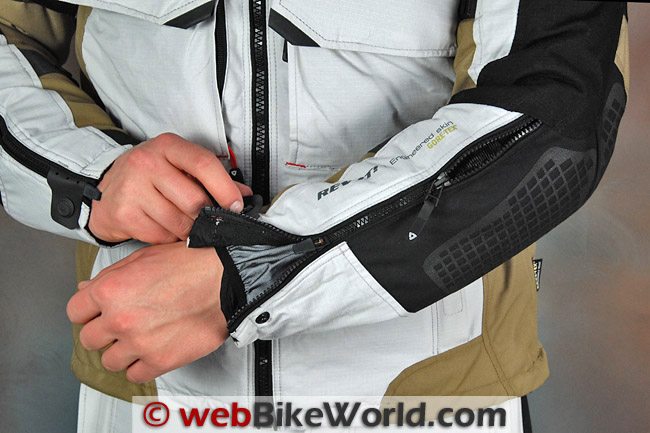
Tailoring and Fit
The details described above are not very subtle, but the tailoring of the jacket probably is. Although in thinking about it, the tailoring of an article of clothing is only a subtle difference until you put it on — then the differences become very apparent.
For example, REV’IT! clothing is usually designed, cut and tailored with what might be called a science and with lots of user feedback. That is the big difference that I have always noticed in their gear.
Cheaper jackets and pants sometimes seem to have been assembled without a lot of thought to the special needs and riding postures of a motorcycle rider.
But talk to any REV’IT! staffer and the conversation quickly turns to a discussion about fit, movement and comfort.
Now that I think about it, I’d say they’re probably obsessed with this topic, seemingly on a never-ending quest to perfect this important aspect of motorcycle apparel.
Our recent longer-distance rides in challenging conditions bears witness to the difference between tailored and what might be called “generic” fit.
The REV’IT! Defender GTX jacket and pants both fit noticeably different than the Firstgear Rainier jacket (review) and Escape pants (review) we were swapping back and forth for purposes of evaluation.
The size large Defender jacket feels like a perfect fit and I usually take a size large. REV’IT! clothing will usually fit tighter than other brands, and that is by design.
The Defender feels like it was designed specifically for my shape, yet it also feels more comfortable than the Rainier jacket, which has a slightly odd shape that isn’t as tailored.
But even with the snug fit, the Defender jacket moves with the body and the closeness of the fit serves several purposes.
First, it helps to keep the armor and protection in place when needed.
Second, it helps prevent wind from entering and also from air pockets forming inside; a major difference from the Firstgear Escape pants, which weren’t nearly as effective in retaining warmth.
The shaped fit of the Defender GTX also helps prevent the jacket and pants from getting blown about at speed, which in itself adds to the comfort factor.
I once had a jacket with arms that flapped around so much I was putting unwanted movement into the handlebars. The extra effort it takes to control that gets old fast, long-distance riding or not.
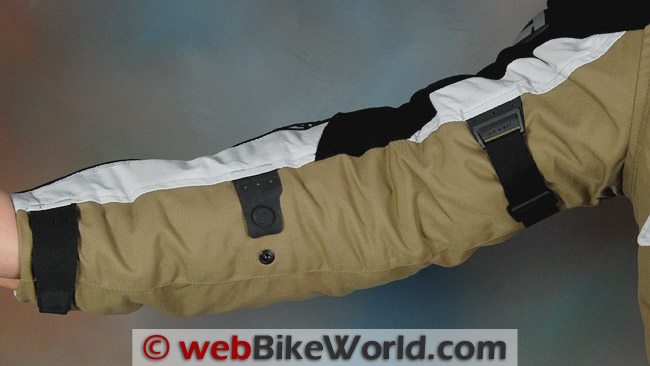
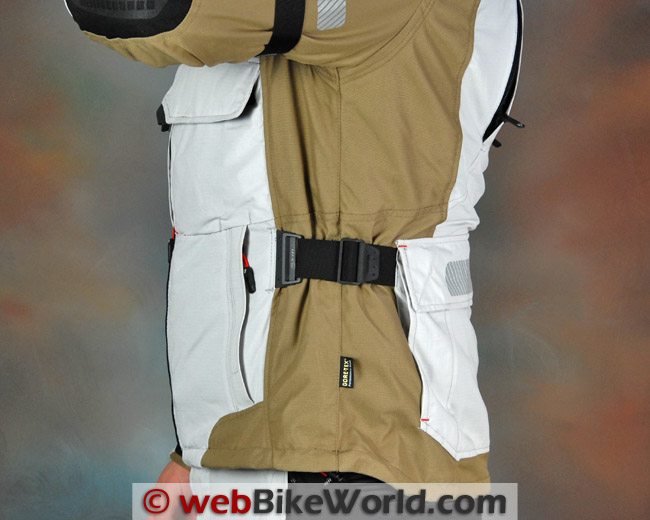
Shell Adjustment System
But most importantly, the fit allows the Defender GTX to be used as a true 4-season garment.
Many motorcycle jackets — especially the less expensive versions with their “sack” fit — gain a size or more when the liners are removed.
The Defender gains perhaps 1/2 size, which means that the jacket still fits well in the summer with the liners removed.
Adjusters are sometimes taken for granted, but there’s more to it than simply throwing on some adjusters for the sake of saying the jacket has them.
The idea is to design the adjusters so that when the liners are removed, the jacket shell can be precisely trimmed to make up for the removed parts.
Too many jackets have adjusters that are basically useless.
The Defender GTX shell has a properly designed adjustment system in the side and arms, along with a secondary snap adjuster at the forearms to prevent that from happening.
This is yet another one of the differences between a high-quality jacket like the Defender GTX and lesser types.
The collar uses the REV’IT! adjustable snap system; the snap sits in a receiver on the right side of the collar that allows it to be located in a range of positions covering about 40 mm.
The left side of the collar has the matching snap and the collar can also be secured open with a loop and hook attached to the outside of the jacket shell.
The collar is lined with the same soft microfiber material used on the inside of the Exkin insulating liner (see below).
Conclusion: Defender GTX Jacket Shell
Those are some of the main differences in the Defender GTX jacket — the stuff you’re paying extra for. The stuff that makes the difference.
This is a bit like choosing a…let’s say a Mercedes E-Series over a Smart ForTwo. They’ll both get you to your destination, but you’re going to feel a lot more comfortable, safer and more luxurious in the Merc.
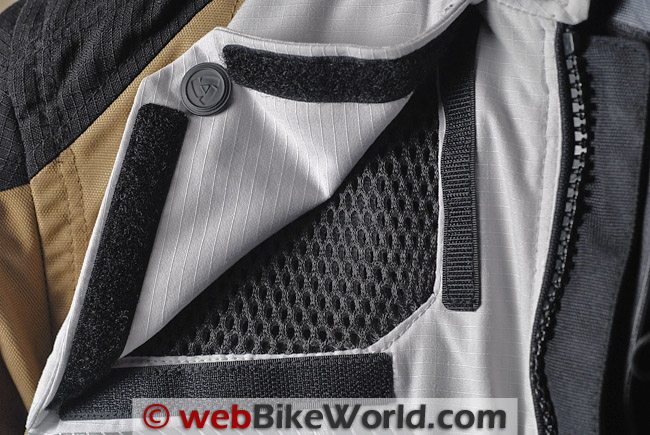
REV’IT! Defender GTX Jacket Shell Details
There are so many details on the Defender GTX that it’s difficult to know where to start. But since so many webBikeWorld readers are interested in a jacket’s ability to keep them dry, let’s start there.
“Guaranteed to Keep You Dry”
We had a couple of good opportunities to give the Defender GTX outfit a good wet-weather workout, along with a bonus, if you will, of cold Fall temperatures thrown in for good measure.
It’s not always possible to schedule rain rides when evaluating motorcycle gear, especially in the on-and-off drought we’ve had here on the East Coast over the last couple of years.
But two Nor’easters came pounding through recently, with lots of wind and fairly torrential rain and we deliberately set out with the REV’IT! Defender GTX and Firstgear Rainier outfits to see what they could do in the ultimate torture test.
Both were waterproof — a surprise actually for the Rainier — but the REV’IT! gear definitely feels warmer and more comfortable, especially the pants.
The Teflon coating on the outer shell fabric of the Defender GTX jacket and pants apparently does the job.
As I mentioned in the Firstgear review, we hung the clothes to dry over the tub and were very surprised when the fabric felt nearly dry after only about 2 hours — and this after a 140 mile ride through heavy rain.
Some people seem obsessed with having the fabric in the jacket shell not absorb water. About the only material that will do that is a plastic, so buy a cheap rain suit to wear over your jacket and you’ll be all set. And hot and sticky.
The real criteria here is how much water gets through to the rider. In this case, it was zero. Underneath the Defender GTX shell and behind the double-overlapping flaps behind the zipper, everything remained dry as dust.
This means that the Gore-Tex Performance Shell really works.
The Performance Shell is one of the best waterproof liners that Gore-Tex makes; the REV’IT! Everest GTX uses the top-of-the-line Gore-Tex Pro Shell Armacor 3-layer for the outer shell, which is one of the main differences between it and the Defender.
The Gore-Tex Performance Shell liner used in the Defender GTX is the 3-layer version; there’s also a 2-layer type. The seams are also laser or heat bonded — sealed, in other words.
The breathable Gore-Tex technology also means there’s no interior moisture buildup, so even when the temperature increased, I did not feel sweaty underneath.
Gore-Tex is very fussy about the use of their name on clothing, and REV’IT! had to pass all sorts of tests and inspections for everything right down to the manufacturing procedures to get the Gore-Tex license.
The Defender GTX jacket comes with the “Guaranteed to Keep You Dry” guarantee directly from Gore-Tex, that’s how confident they are in the product.
The guarantee states “If you are not completely satisfied with the waterproofness, windproofness or breathability of our Gore-Tex outerwear, we will repair it, replace it or refund your purchase price“.
So add that in to the purchase price — there aren’t many other motorcycle jackets you can buy that give you a guarantee like that.
More on the REV’IT! Gore-Tex partnership in our REV’IT! Gore-Tex Motorcycle Clothing Previewand news of the REV’IT! Gore-Tex Test Team, which is used to test prototype REV’IT! Gore-Tex products with riders around the world.
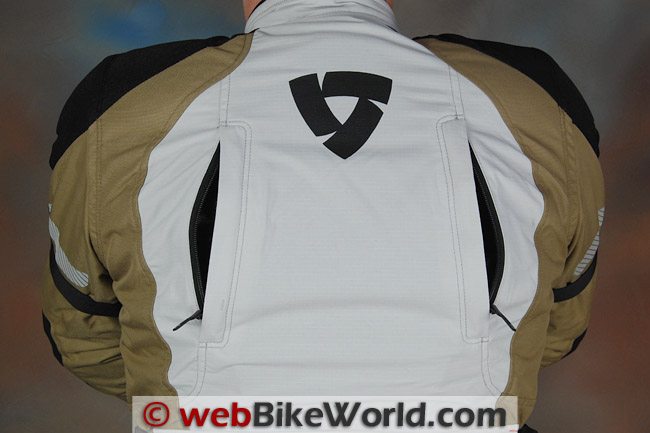
Staying Warm and Cool
Exkin Insulating Liner
REV’IT! has been using the Exkin brand of insulating liner in their jackets for some time. T
his is a lightweight liner that feels “puffy”, yet thin. It really works and is probably one of the most efficient non-heated liners available for motorcycle gear. It is lined with a very soft microfiber material along the front and the sides of the neck.
The liner easily removes from the jacket, as illustrated in the Part 2 YouTube video.
REV’IT! has now color-coded the zippers and attachments, which makes it much easier to install the liners, which also have a snap at the neck and cuffs.
The Defender GTX has dual sets of zippers, which allows the Exkin liner to be attached to the jacket shell itself or the insulating liner.
This gives a lot of flexibility in the jacket because the jacket can be 1) Worn alone as a shell with the liners removed; 2) With just the waterproof liner; 3) With just the Exkin liner; 4) With both liners.
The inside of the jacket shell, by the way, is nicely lined with a soft-feel mesh, so it feels comfortable even wearing a simple T-shirt.
During our rain/monsoon rides, I deliberately did not wear any thermal or windproof underwear. I wore only a pair of cotton undershorts and T-shirt and a thin cotton long-sleeved turtleneck.
I was perfectly warm and dry the entire time, which is really amazing I think in the high-40’s to low-50’s (Fahrenheit) temperatures and pounding rain.
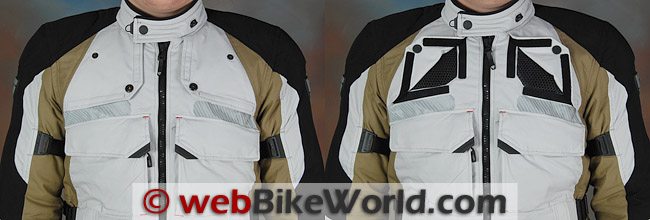
Ventilation
The Defender GTX is designed as a four-season jacket; a task not as easy as it may seem. A jacket shell that protects against cold and rain in winter will usually feel too warm in the summer.
So this is another area where careful design and construction techniques come into play — features like sealed seams and waterproof pockets and zippers.
Another engineering trick is to design vents that work without leakage, and this is yet another one of those differences that can add to the cost of a higher-quality jacket.
The Defender GTX has a unique venting system at the upper chest. The vents on either side are covered with a fabric flap, which can be folded up and secured with metal Fiocchi (Italy) snaps.
Doing so uncovers the REV’IT! “3D” mesh, a thick mesh designed to allow a large volume of air flow while keeping the mesh offset from the body to allow better circulation.
This is a system that has gone through an evolution that can be traced back through the excellentREV’IT! Sirocco jacket (review), the Cayenne Pro and others, with the Defender GTX having the latest version of the design.
It really works and is one of the most clever vent designs available in my opinion, because it opens a very large surface area when compared to a simple zippered vent that opens only a few millimeters wide.
The Defender GTX also has two vertical vents located in the rear; these are about 8″ (200 mm) long, located on either side of the back and lined with nylon mesh.
Although the weather is too cold to ride with all of the vents open, I removed the liners and opened the front and rear vents and the system provides excellent ventilation.
The 3D mesh works to keep the fabric from pushing against the chest and this allows a large volume of air to pass into the jacket.
The rear vents are in the low pressure zone, and the air feels like it’s being pulled through the jacket and out the back, similar to the method used to ventilate a motorcycle helmet.
The jacket includes two hidden front vents on the inside of either front pocket.
These are “secret” vents that remained hidden until Jordan Levitt showed them to me when I viewed the prototype Defender GTX jacket in the these Part 1 and Part 2 YouTube videos.
The Defender GTX has one more set of vents located along the bottom half of each sleeve. These are covered with very heavy-duty YKK locking zippers of a type I haven’t seen before.
The zipper pull is spring-loaded and it locks into place when the two-way vent is opened, either from the top down or bottom up.
These vents are a very long 11″ (28 cm) and backed by mesh to about 3/4 of the way down to the cuff to allow some tapering at the cuffs to fit into glove gauntlets.
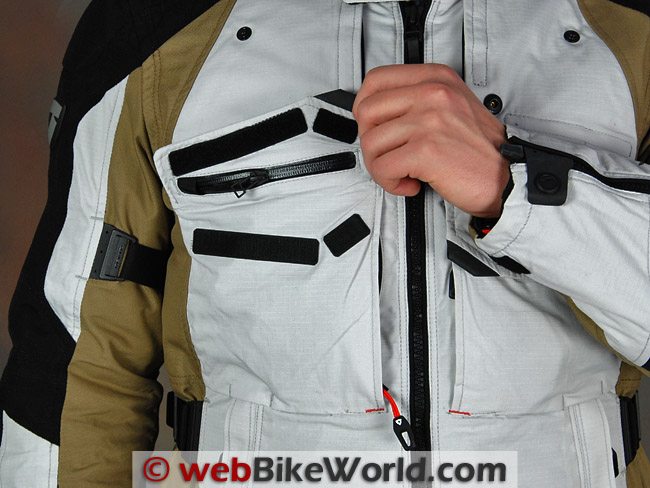
Defender GTX Storage
Pockets – External
The Defender GTX has a new pocket layout, based on feedback from Cayenne Pro owners, who asked for fewer pockets, an interesting switch from the “more is better” design philosophy used by some manufacturers.
The differences are that the two lower cargo pockets found on the Cayenne Pro were replaced by two hand-warmer pockets with vertical zippers on the Defender GTX.
The upper chest pockets are now larger, with Gore-Tex waterproof lining, a fold-over flap and a waterproof zipper underneath.
I deliberately put my wallet in one pocket and cell phone in the other during the rain rides and both came out perfectly dry, so these pockets work.
I think they’re also easier to access than the lower cargo pockets used on the Cayenne Pro, which sometimes required two hands to open.
The rear of the jacket features a large storage pocket that can hold the liners or other gear.
This is a huge pocket of about 16″ across and 9″ deep (40 by 23 cm) and it even has folded and sewn expansion pleats at the side that allow the pocket to be overstuffed if necessary.
Internal Pockets
The Exkin jacket liner has a pocket on either side at the upper chest, covered by a vertical zipper. The Gore-Tex Performance Shell has a sealed pocket on the right side made with the Gore-Tex material, so it is also waterproof.
The Defender shell also has a horizontal pocket inside the left chest.
Protection, Padding and Armor
SAS-Tec Brand Protectors
REV’IT! uses the high-quality SAS-Tec GmbH brand protectors (SAS – “Sicherheit aus Schaum” or Safety of Foam/Safety of Foam Systems) in the higher-end jackets and pants.
The Defender GTX features SAS-Tec protectors in the shoulders and elbows.
The fit of the jacket is designed to help keep the armor in place and the protectors are curved and molded to fit the left and right sides individually (see the Firstgear Rainier jacket review for photos comparing the SAS-Tec armor with the d3o protectors).
The jacket has a thinner EVA foam back pad and the pocket is designed to fit an optional SAS-Tec back protector which is a $44.99 option.
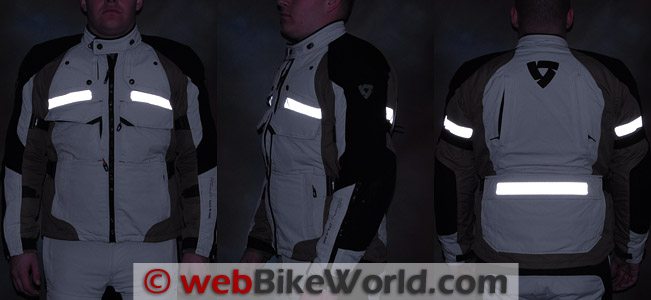
Miscellaneous Features
Reflectivity
The Defender GTX has strips of 3M highly retro-reflective material located on the chest, arms and back. The material is very thin and sealed on to the body of the shell without stitching, which helps improve the water resistance.
You can see in the photo above that the material really pops when hit by light.
Sleeve Cuffs
The sleeve vents described above are one part of the cuff adjustment system. The cuffs also have a long section of hook-and-loop with a rubber-coated strap for adjustment.
The system, which includes the shorter length mesh liner also described above, allows the sleeves to be adjusted to the rider’s preference, then the lower part of the zipper is opened to allow quick entry and exit.
This avoids the necessity of re-adjusting the hook-and-loop strap each time the jacket is worn and it saves wear and tear on the hook-and-loop.
| The wBW Opinionator: REV’IT! Defender GTX Jacket | |
|---|---|
| Picks… | …and Pans. |
|
|
Conclusion
The REV’IT! Defender GTX jacket is a worthy upgrade from the very popular Cayenne series, which is still in production.
The Defender fills a new niche above the Cayenne Pro, which was formerly at the top of the REV’IT! jacket product line, and the new Everest GTX, which is the new ultimate no-compromise REV’IT! jacket.
Although we didn’t have the Defender GTX to wear in warmer weather, experience tells us (along with owner feedback) that it will make an excellent four-season jacket.
It’s proven waterproof and guaranteed by Gore-Tex and the Exkin liner is nearly magical in providing warmth with lightness.
There really isn’t much to nitpick on this jacket, other than the back protector, which would be a nice standard addition. Yes, the price may seem high…but is it really?
You can buy a Defender GTX and get a truly waterproof jacket that can be used in four seasons and has the highest levels of quality and protection.
Or you can buy two outfits of lesser quality for the same price or more and possibly end up with compromises in both.
There’s definitely a market for high-end, rugged, “professional” style motorcycle clothing and the Defender GTX certainly fits that mold. I can highly recommend it.
Next: REV’IT! Defender GTX Pants Review | wBW REV’IT! Clothing Reviews
| wBW Product Review: REV’IT! Defender GTX Jacket | |
|---|---|
| The REV’IT! Defender GTX outfit was named the webBikeWorld 2010 Motorcycle Product of the Year! | |
| Manufacturer: REV’IT! | List Price (2012): $699.99 |
| Colors: Black or White with Red, Black or Tan. | Made In: Indonesia |
| Sizes: S-3XL | Review Date: December 2010 |
Owner Comments and Feedback
See details on submitting comments.
From “J.C.” (02/11): “Now that I have about 700 miles on my REV’IT! Defender GTX jacket I thought you might appreciate hearing about my experience with it.
In summation I’ll say that in my forty plus years of motorcycling I have never had a piece of riding gear of such high quality.
Luckily, I haven’t as yet ridden in the rain while wearing it, so I have no comments on its wet weather performance.
However, the Spring weather here in Western North Carolina has produced temperatures ranging from 40 to 70 degrees over the week I’ve had the Defender.
At 40 degrees the jacket with liners in place was very comfortable, though I anticipate replacing the insulated liner with a heated liner when the temperatures dip into the 30s.
Two days ago we had a bright sunny 70-degree day. I removed both liners and opened the vents and was very comfortable even behind a full fairing on my touring bike.
None of my comments above, though, address the myriad of features, attention to detail, innovation, quality and classy good looks of this product. I will be wearing it for many miles knowing I am well protected from the environment and the road.
Thanks so much for the great review you did on this jacket. Without that I would never have known how good a motorcycle garment could be or why it would be well worth spending $750 on it.”


